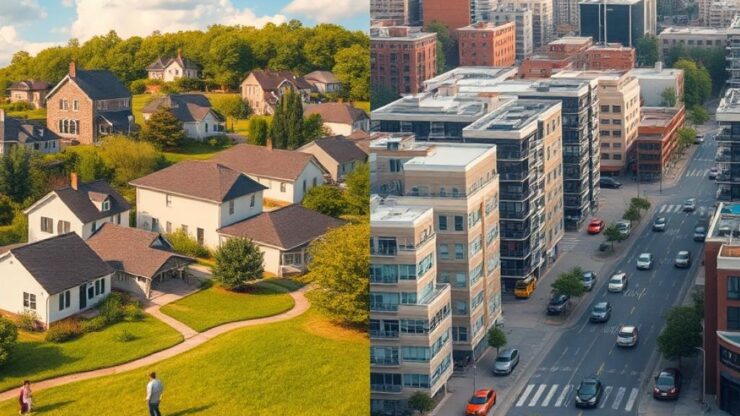Lifestyle Differences: Urban vs. Suburban

Urban living offers a vibrant lifestyle that appeals to those who thrive on energy and diversity. Cities are often characterized by their fast-paced environment, cultural richness, and access to amenities. Residents enjoy a plethora of options for dining, entertainment, and socializing, making urban life alluring for many homebuyers.
However, this lifestyle comes with its own set of challenges. High population density often leads to crowded spaces, higher costs of living, and limited availability of larger living spaces. Below is a list of the pros and cons of urban living.
- Pros: Proximity to work, diverse culture, extensive public transport, vibrant nightlife.
- Cons: Higher cost of living, noise pollution, limited green spaces, and potential safety concerns.
In contrast, suburban living provides a quieter, more spacious alternative to urban life. Suburbs are often viewed as family-friendly environments, offering larger homes, yards, and a sense of community. This lifestyle appeals to those seeking a balance between convenience and tranquility, especially families with children.
While the suburbs may lack the immediacy of urban amenities, they often provide a more relaxed pace of life, with access to parks and recreational activities. Below is a comparison table illustrating some key lifestyle differences between urban and suburban living.
| Feature | Urban Living | Suburban Living |
|---|---|---|
| Cost of Living | Generally higher | More affordable |
| Space | Limited, smaller living areas | More spacious, larger homes |
| Commute | Shorter, often walkable | Longer, requires a car |
| Cultural Amenities | Abundant | Limited |
| Community Feel | Diverse, but less intimate | Close-knit, family-oriented |
When deciding between urban and suburban living, homebuyers must consider their personal preferences, lifestyle needs, and long-term goals. Each option presents unique advantages and drawbacks, making it essential to weigh these factors carefully. Ultimately, the choice between urban and suburban living will shape not only your immediate environment but also your overall life experience.
Cost of Living: Analyzing Financial Implications
The decision to purchase a home in an urban or suburban environment is significantly influenced by the cost of living. Understanding the financial implications associated with each lifestyle choice is crucial for homebuyers aiming to make an informed decision. As we delve deeper into this topic, we will explore various components that contribute to the overall cost of living in both urban and suburban areas, helping potential buyers weigh their options more effectively.
Housing expenses form the cornerstone of the cost of living, significantly impacting monthly budgets. In urban areas, while property prices tend to be higher, the trade-off often comes with the convenience of shorter commutes and proximity to work and social activities. On the other hand, suburban homes usually provide greater square footage and outdoor space for a more reasonable price, yet they might entail additional commuting costs and time.
Beyond housing, there are other financial considerations that can sway a homebuyer’s decision. Urban living often incurs higher costs in everyday expenses such as groceries, dining, and entertainment, primarily due to increased demand and operational costs for businesses in densely populated areas. Conversely, suburban living can lead to savings in these categories, although one must factor in the potential costs related to transportation and vehicle maintenance due to less public transit availability.
To succinctly summarize the financial implications of urban versus suburban living, consider the following list of key factors:
- Property Prices: Urban homes are generally more expensive than suburban properties.
- Commuting Expenses: Suburban living may lead to higher commuting costs due to distance from urban centers.
- Groceries and Dining: Urban areas often have higher prices for food and dining options.
- Utility Costs: Urban residences may incur higher utility costs due to demand.
- Long-term Investment: Suburban homes may offer better long-term investment potential because of space and value appreciation.
Ultimately, it is essential for prospective homebuyers to thoroughly evaluate their financial situations and lifestyle preferences when considering the cost of living in urban versus suburban settings. A thoughtful analysis will not only aid in making a sound investment but also ensure that the chosen environment aligns with personal and family needs.
Accessibility and Commute: Evaluating Transportation Options
Transportation plays a pivotal role in shaping the overall living experience for homebuyers, influencing not only daily routines but also lifestyle choices. As urban and suburban environments vary significantly in their accessibility and commuting options, understanding these differences is critical for prospective residents. Whether it’s the convenience of public transit in the city or the reliance on personal vehicles in the suburbs, each choice carries its own implications for time management, cost, and overall quality of life.
Urban living is synonymous with convenience, especially when it comes to transportation. Cities typically boast an extensive network of public transit options, including buses, subways, and light rail systems. For many city dwellers, this offers a reliable and often economical way to navigate their daily commutes.
Moreover, urban areas tend to have a higher density of amenities within walkable distances. Residents often find that they can accomplish errands, enjoy leisure activities, and socialize without needing to rely on a vehicle. However, while public transport can alleviate the stress of commuting, it is not without its drawbacks, such as crowded conditions during peak hours and occasional service delays.
In contrast, suburban living often requires a different approach to transportation. Suburban areas typically provide more spacious homes and quieter streets, yet they often lack the same level of public transit accessibility found in cities. As a result, many suburban residents depend heavily on personal vehicles for commuting, which can lead to longer travel times and increased fuel costs.
This reliance on cars can create a sense of isolation for some, as amenities may not be within walking distance. However, the trade-off includes wider roads and less congestion, which can make for a more pleasant driving experience. Additionally, suburban neighborhoods frequently feature ample parking options and can provide a sense of freedom in mobility.
When deciding between urban and suburban living, it is essential to assess individual transportation needs and preferences. Below is a summary of key considerations that can help homebuyers evaluate their options:
- Public Transport Availability: Cities often have extensive public transport systems, while suburbs may have limited options.
- Commute Times: Urban commutes can be shorter but crowded; suburban commutes may be longer but less congested.
- Cost of Transportation: Urban living may save on fuel costs but incur higher public transport fees, while suburban living could lead to increased vehicle expenses.
- Walkability: Urban areas typically offer better walkability, while suburbs may require a car for most errands.
Ultimately, the choice between urban and suburban living hinges not only on lifestyle preferences but also on how transportation fits into the daily routine. A thoughtful evaluation of commuting options can greatly influence the overall satisfaction and quality of life in either setting.
Community and Social Life: Building Relationships
When it comes to choosing between urban and suburban living, the fabric of community and social life plays a pivotal role in shaping a homeowner’s experience. Each environment presents distinct opportunities for building relationships, engaging with neighbors, and fostering a sense of belonging. Understanding these dynamics can significantly influence homebuyers’ decisions, as the quality of social interactions often correlates with overall happiness and fulfillment in one’s living situation.
Urban environments are characterized by their vibrant and diverse communities, where individuals from various backgrounds converge. This melting pot of cultures can lead to enriching social experiences, allowing residents to engage in a wide array of activities, events, and gatherings. The hustle and bustle of city life often facilitates spontaneous interactions, whether through community festivals, art exhibits, or casual meet-ups in local cafés.
However, while urban settings may offer numerous opportunities to meet new people, the fast-paced lifestyle can sometimes hinder the depth of relationships. The sheer volume of residents may create a sense of anonymity, making it challenging to form lasting connections. Consequently, individuals seeking deep-rooted friendships may find themselves navigating a labyrinth of acquaintances, often leading to a feeling of isolation amidst the crowd.
In contrast, suburban areas often provide a more intimate atmosphere where neighbors know one another and community ties are emphasized. The slower pace of life in the suburbs fosters an environment conducive to building meaningful relationships. Families often engage in activities such as neighborhood barbecues, school events, and local sports, creating opportunities for residents to connect on a personal level.
The spaciousness of suburban living also allows for more communal spaces, such as parks and recreational centers, where families can gather and socialize. This sense of community not only enhances social life but also contributes to a supportive environment for children to grow and thrive. Suburban neighborhoods often pride themselves on a strong sense of belonging, where residents actively participate in local initiatives and activities, reinforcing the bonds that tie them together.
Ultimately, the choice between urban and suburban living in terms of community and social life comes down to personal preferences. Homebuyers must consider what type of social interactions resonate with their lifestyle aspirations. Whether it’s the dynamic interactions of city life or the nurturing environment of the suburbs, understanding the implications of community connections can significantly enhance one’s living experience.
Real Estate Trends: Market Analysis for Homebuyers
As homebuyers navigate the complex landscape of real estate, understanding the current market trends is paramount. The decision to invest in suburban or urban properties is influenced not only by personal preferences but also by broader economic factors. In recent years, shifts in demographics, workplace flexibility, and lifestyle preferences have significantly impacted housing markets across the nation, creating a dynamic environment for prospective homeowners.
Urban Market Dynamics: Cities have long been seen as the epicenter of economic activity, attracting a diverse population seeking opportunities and amenities. However, rising property prices in urban settings have prompted many potential buyers to reassess their options. With the advent of remote work, the demand for urban housing has begun to plateau, leading to a potential shift in market dynamics. Urban homes, once considered a hot commodity, are now subject to increased scrutiny as buyers weigh the financial implications of high costs versus the convenience of city life. Moreover, developers are responding to this trend by introducing innovative housing solutions, such as micro-apartments and co-living spaces, which cater to a younger demographic looking for affordable living in bustling city environments.
Suburban Growth and Appeal: Conversely, the suburbs have witnessed a resurgence in popularity, particularly among families and individuals seeking more space and a sense of community. The allure of larger homes, green spaces, and a lower cost of living has led to a surge in suburban real estate development. Many homebuyers are now prioritizing features such as home offices and outdoor areas, reflecting a shift in lifestyle preferences that favor comfort and flexibility. This growing interest has resulted in increased competition for suburban properties, often leading to bidding wars and rising prices. Builders are capitalizing on this trend by offering new constructions with modern amenities that meet the evolving needs of families, thereby enhancing the suburban appeal.
Investment Considerations: For homebuyers, understanding the real estate trends is crucial for making informed investment decisions. While urban living may still offer a vibrant lifestyle, the financial implications of high property values and increased living costs cannot be overlooked. On the other hand, suburban properties may present better long-term investment opportunities, as they often appreciate in value and provide more space for families to thrive. Additionally, the current market indicates that suburban areas may continue to grow in demand, driven by lifestyle changes and a desire for community-oriented living. As such, prospective homeowners must carefully analyze their personal needs, financial capabilities, and long-term goals when considering whether to invest in urban or suburban real estate.
Disclaimer
This article has been created or edited with the support of artificial intelligence and is for informational purposes only. The information provided should not be considered investment advice. Please seek the support of a professional advisor before making any investment decisions.






